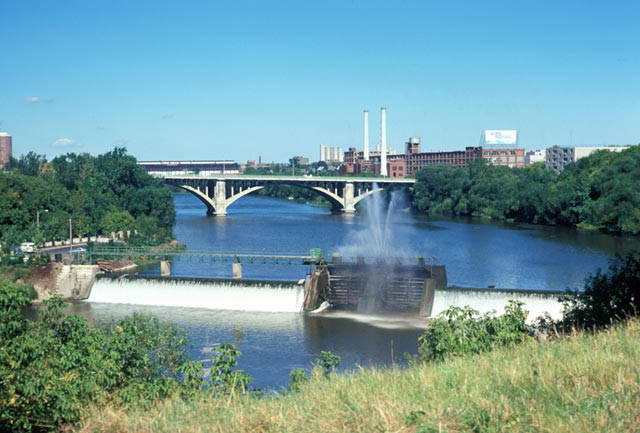The RiverWalk is a pedestrian walkway along the Milwaukee River in downtown Milwaukee. Socialist city planners first envisioned the RiverWalk in the early 20th century, and a segment was built outside the Gimbels Department Store in the late 1920s.[1] In the 1980s, Mayor Henry Maier revived the idea and pushed for a connected system of pedestrian walkways along the river.[2] In 1985, the Greater Milwaukee Committee and the City of Milwaukee rebuilt the Gimbels segment.[3] Other riverfront property owners built their own segments.[4] A completion plan requested by the Wisconsin Department of Natural Resources helped ensure compliance with the public trust doctrine, which mandates public access to waterways.[5]
In 1993, Mayor John Norquist’s $9.7 million “RiverWalk Initiative” guided the construction of a walkway from Clybourn Street to Pleasant Street on the west bank of the river and to Highland Avenue on the east bank.[6] The RiverWalk helped attract investors who constructed numerous nearby apartment buildings and restaurants, among other new commercial activity.[7] This success allowed Norquist to expand the RiverWalk into the Historic Third Ward and along Commerce Street.[8]
Today the RiverWalk has three main segments. The original segment follows the river downtown. The Historic Third Ward Segment, the southernmost portion, was completed in 2004 and won a design award in 2007.[9] The northern section of the RiverWalk, the Beerline “B” segment, follows a former industrial rail line from North Humboldt Avenue to East Pleasant Street.[10] RiverSplash, a festival centered on the RiverWalk, was held annually between 1989 and 2009.[11]
Footnotes [+]
- ^ Joseph A. Rodriguez, Bootstrap New Urbanism: Design, Race, and Redevelopment in Milwaukee (Lanham, MD: Lexington Books, 2014), 7, 63.
- ^ Tom Daykin, “RiverWalk Turns 20 and Is Still Growing,” Milwaukee Journal Sentinel, September 17, 2011, accessed March 14, 2015.
- ^ City of Milwaukee website, “RiverWalk History,” accessed March 14, 2015; Rodriguez, Bootstrap New Urbanism, 63.
- ^ Tom Daykin, “RiverWalk Turns 20 and Is Still Growing,” Milwaukee Journal Sentinel, September 17, 2011, accessed March 14, 2015.
- ^ City of Milwaukee website, “RiverWalk History,” accessed March 14, 2015.
- ^ Tom Daykin, “RiverWalk Turns 20 and Is Still Growing,” Milwaukee Journal Sentinel, September 17, 2011, accessed March 14, 2015.
- ^ Tom Daykin, “RiverWalk Turns 20 and Is Still Growing,” Milwaukee Journal Sentinel, September 17, 2011, accessed March 14, 2015.
- ^ Tom Daykin, “RiverWalk Turns 20 and Is Still Growing,” Milwaukee Journal Sentinel, September 17, 2011, accessed March 14, 2015.
- ^ City of Milwaukee website, “RiverWalk History,” accessed March 14, 2015.
- ^ City of Milwaukee website, “RiverWalk History,” accessed March 14, 2015.
- ^ “Milwaukee Riverwalk District Kills RiverSplash,” OnMilwaukee.com, December 22, 2009, accessed March 14, 2015.
For Further Reading
City of Milwaukee. “RiverWalk History.” Department of City Development. Accessed March 14, 2015.
Rodriguez, Joseph A. Bootstrap New Urbanism: Design, Race, and Redevelopment in Milwaukee. Lanham, MD: Lexington Books, 2014.
See Also
One Comment
Please keep your community civil. All comments must follow the Encyclopedia of Milwaukee Community rules and terms of use and will be moderated prior to posting. Encyclopedia of Milwaukee reserves the right to use the comments we receive, in whole or in part, and to use the commenter's name and location, in any medium. See also the Copyright, Privacy, and Terms & Conditions.
If you need to contact the editors please use the Contact Form.
Leave a Comment
You must be logged in to post a comment.

I cannot find any reference to the news stories burned in the wood planks of the River Walk. The stories run from north of the Sail Loft restaurant to near the black spiral metal and concrete rise up to street level. No one knows who did it or paid for it. I assume the letters were burned in with a laser. Just the record keeping of all the dates and stories was a large task. Big mystery.
The first time I looked at an article it was the Battle of Midway. That was the critical naval engagement in the Pacific where our navy sunk a lot of the Japanese ships, battleships and carriers. That ended Japanese dominance and started their defeat.